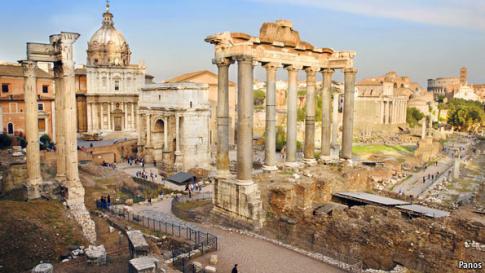Noisy and eternal

If Rome’s history is monumental, then so is the task of telling it. A story that lasts almost 3,000 years and is pivotal to so much of Western civilisation requires a chronicler of well-nigh unattainable erudition...
By Robert Hughes
NO CITY, writes Robert Hughes, “has ever been more steeped in ferocity from its beginnings than Rome”.
This dauntingly aggressive city-state made itself the capital of Europe’s biggest empire, and then became the seat of western Christendom. Unsurprisingly, it has acted as a magnet for men (and the occasional woman) of intimidating ambition, untroubled by the use of violence for the attainment of their ends.
One of the city’s semi-legendary rulers was Tarquin the Arrogant who is credited with inspiring the “tall poppy” approach to governance: he reputedly believed the best way to start administering a vanquished city was to remove the heads of its leading citizens. Among Rome’s later emperors was Valens, whose purge of pagans was described by one fourth-century chronicler as “monstrous savagery”. As Mr Hughes writes, “men were maimed, hideously torn with hooks, and dragged off to the scaffold and the chopping-block.”
More than a millennium later, the city was in thrall to “quarrelsome, tough, crazy” Pope Sixtus V, as a later poet called him. A 16th-century proponent of zero tolerance, Sixtus had those who failed to keep the Sabbath condemned to the galleys. Sixtus’s violent, if productive, five-year papacy exemplified a recurrent theme in Rome’s history: the entwining of brutality with lavish creativity. It was he who built many of the straight roads and broad squares on which his successors bestowed the Baroque churches and fountains that have been the city’s pride ever since.
If Rome’s history is monumental, then so is the task of telling it. A story that lasts almost 3,000 years and is pivotal to so much of Western civilisation requires a chronicler of well-nigh unattainable erudition, who can write with the skill needed to prevent readers from succumbing to a literary version of Stendhal syndrome. Mr Hughes, the Australian-born art critic of Time magazine, comes as near as anyone to fulfilling that job description and for much of this wide-ranging volume he succeeds magnificently. He is at his most instructive and entertaining in the period that roughly coincides with the construction of Saint Peter’s basilica, which “took 120 years and lasted for the lifetime of 20 popes”. This was the age of Bramante, Michelangelo, Julius II the “terrifying Pope”, and that eccentric Baroque master, Guido Reni, who was so scared of women that only his mother was allowed to touch his laundry. This was also the period that encompassed the Roman sojourn of Caravaggio whose violence and genius were so much of a piece with the city’s history. “Saturnine, coarse and queer”, writes Mr Hughes, that “he thrashed about in the etiquette of early Seicento Rome like a shark in a net.”
Prose of that quality is of itself enough to commend this work. But there is no denying the book is uneven. There are disconcerting inaccuracies: Mr Hughes seems to think polenta is characteristically Roman when in fact it is quintessentially northern. And at times he fails to exert on his work the iron discipline that characterises the only comparable work in English, Christopher Hibbert’s “Rome: The Biography of a City”, published in 1985. Mr Hughes’s account of the Republic, for example, drifts away from the city itself to become the story of the making of the Roman empire. More jarringly, the chapters supposedly devoted to the city’s 20th-century history dwell at length on individuals and movements who had little to do with Rome or, like the Futurists, actively loathed it. The entire section could be retitled “A Brief History of Modern Italian Art”.
By then, you feel the author has been exhausted by the sheer richness of his material. Rome, he writes, “makes you feel small, and it is meant to.” But then he adds: “It also makes you feel big, because the nobler parts of it were raised by members of your own species. It shows you what you cannot imagine doing, which is one of the beginnings of wisdom.”economist.com




 del.icio.us
del.icio.us Digg
Digg

Post your comment